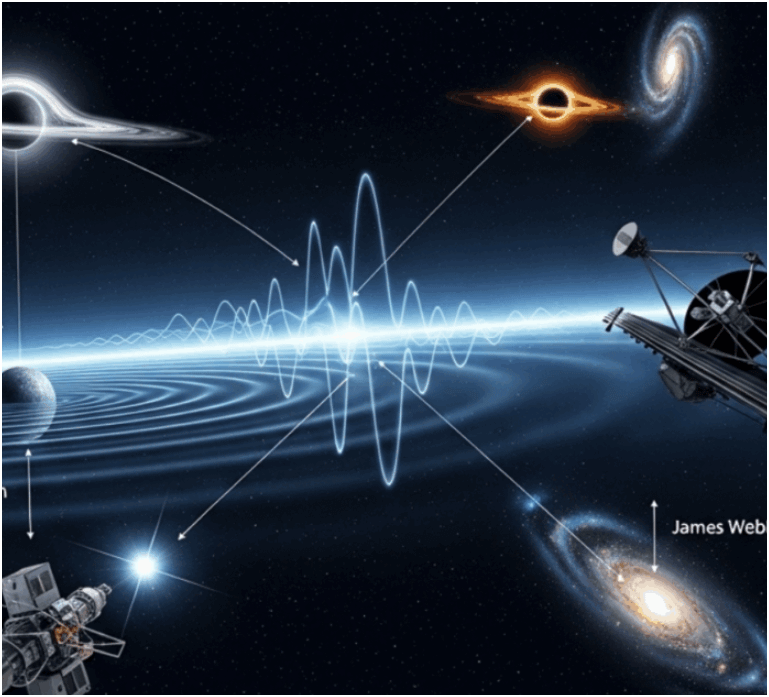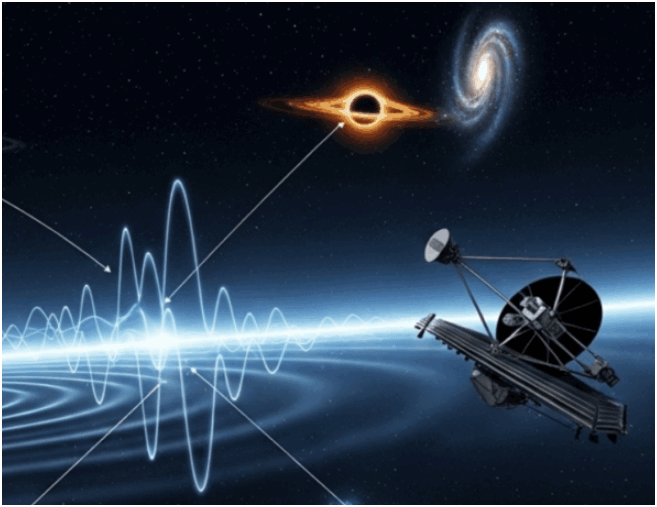Created with 2.5 Flash July 8, 2025 at 12:41 PM Published July 8, 2025 at 12:42 PM
Chinese gravitational scientists have been making significant strides, particularly in the realm of gravitational wave detection. While the James Webb Space Telescope (JWST) is an infrared observatory and not a gravitational wave detector itself, there are exciting avenues where Chinese gravitational science discoveries could inform or complement JWST’s observational capabilities.

Here are some key areas:
1. Nanohertz Gravitational Waves and Early Universe:
- Chinese Discovery: The Chinese Pulsar Timing Array (CPTA) research group, using the FAST telescope, has found key evidence for the existence of nanohertz gravitational waves. These waves are thought to be generated by supermassive black holes merging in the early universe.
- JWST Connection: JWST is uniquely designed to observe the early universe and detect the first galaxies and quasars. If nanohertz gravitational waves are indeed generated by the mergers of supermassive black holes that seeded early galaxy formation, then JWST’s observations of these early, massive galaxies and their central black holes could provide electromagnetic counterparts or contextual information to the gravitational wave signals.
- Experimentation: JWST could:
- Identify host galaxies: Search for the optical/infrared signatures of galaxies where such supermassive black hole mergers might have occurred, potentially revealing more about the environments that produced these gravitational waves.
- Characterize early black holes: Its ability to observe high-redshift objects could help characterize the properties of the supermassive black holes in the early universe, which are the likely sources of nanohertz gravitational waves.
- Probe galaxy evolution: Investigate the relationship between the distribution and evolution of early galaxies and the expected distribution of nanohertz gravitational wave sources, helping to connect gravitational wave astronomy with galaxy evolution studies.
- Experimentation: JWST could:
2. Multi-Messenger Astronomy:
- Chinese Initiatives: While not a direct discovery yet, China has proposals for space-based gravitational wave detectors like Taiji and TEGO, which aim to detect different frequency ranges of gravitational waves compared to ground-based observatories. They are also developing missions like the Gravitational Wave Electromagnetic Counterpart All-sky Monitor (GECAM).
- JWST Connection: The broader field of multi-messenger astronomy, where gravitational wave detections are combined with electromagnetic observations, is a crucial frontier.
- Experimentation: If future Chinese gravitational wave observatories detect events, especially those with an electromagnetic counterpart (like merging neutron stars or black holes tearing apart stars), JWST could:
- Observe the electromagnetic aftermath: Use its infrared capabilities to observe the thermal emission, dust, and molecular gas associated with these violent cosmic events, providing a more complete picture of the physics involved.
- Study heavy element formation: Specifically for neutron star mergers, JWST could look for the infrared signatures of newly synthesized heavy elements (like gold and platinum) that are thought to be produced in these events, complementing gravitational wave detections of such mergers.
- Experimentation: If future Chinese gravitational wave observatories detect events, especially those with an electromagnetic counterpart (like merging neutron stars or black holes tearing apart stars), JWST could:
3. Probing General Relativity and Dark Matter/Energy:
- Chinese Proposed Observatories: Projects like TEGO are designed to search for more polarization modes of gravitational waves than predicted by Einstein’s General Theory of Relativity, which could signal “new physics.” China’s CSST (China Space Station Telescope) will also focus on weak gravitational lensing, which maps the distribution of dark matter.
- JWST Connection: While JWST doesn’t directly detect gravitational waves, its precise imaging and spectroscopic capabilities are vital for:
- Weak lensing studies: Although CSST is explicitly designed for this, JWST’s deep and high-resolution imaging can contribute to understanding large-scale structure and dark matter distribution by observing subtle distortions in the shapes of distant galaxies caused by gravitational lensing.
- Connecting with theoretical models: Any anomalies detected by gravitational wave observatories that challenge General Relativity could then be explored through JWST’s observations of extreme astrophysical environments (e.g., around black holes or neutron stars) to see if those observations align with the new theoretical frameworks.
In essence, Chinese gravitational science is opening new “windows” to observe the universe through gravitational waves. The James Webb Space Telescope, with its unparalleled infrared vision, can act as a powerful complementary tool, providing crucial electromagnetic data to interpret and contextualize these gravitational wave discoveries, especially those originating from the early universe or involving compact objects.
